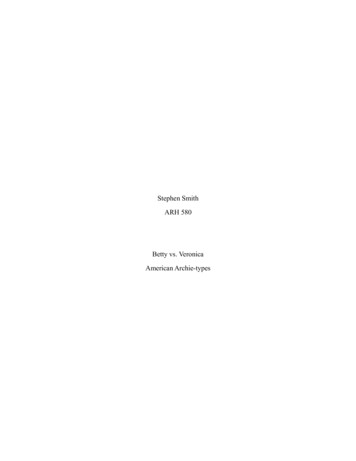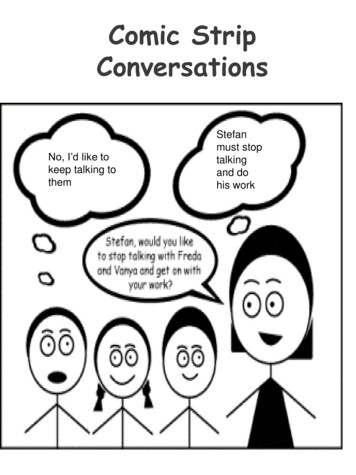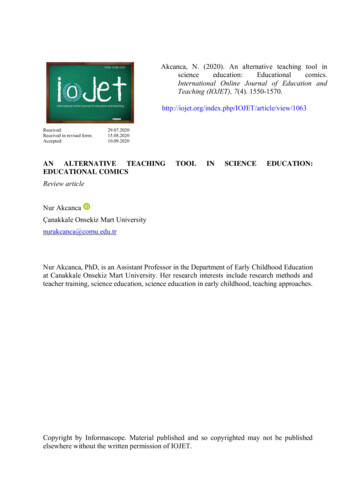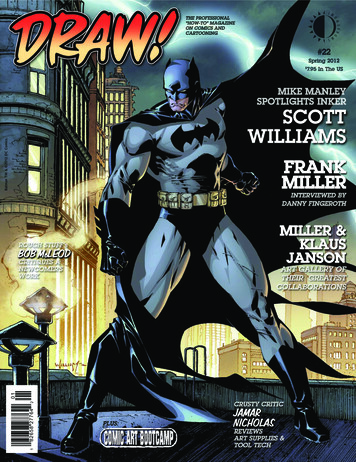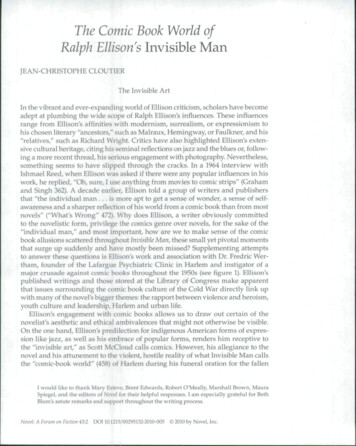
Transcription
The Comic Book World ofRalph Ellisons Invisible ManJEAN-CHRISTOPHE CLOUTIERThe Invisible ArtIn the vibrant and ever-expanding world of Ellison criticism, scholars have becomeadept at plumbing the wide scope of Ralph Ellison's influences. These influencesrange from Ellison's affinities with modernism, surrealism, or expressionism tohis chosen literary "ancestors," such as Malraux, Hemingway, or Faulkner, and his"relatives," such as Richard Wright. Critics have also highlighted Ellison's extensive cultural heritage, citing his seminal reflections on jazz and the blues or, following a more recent thread, his serious engagement with photography. Nevertheless,something seems to have slipped through the cracks. In a 1964 interview withIshmael Reed, when Ellison was asked if there were any popular influences in hiswork, he replied, "Oh, sure, I use anything from movies to comic strips" (Grahamand Singh 362). A decade earlier, Ellison told a group of writers and publishersthat "the individual man . . . is more apt to get a sense of wonder, a sense of selfawareness and a sharper reflection of his world from a comic book than from mostnovels" ("What's Wrong" 472). Why does Ellison, a writer obviously committedto the novelistic form, privilege the comics genre over novels, for the sake of the"individual man," and most important, how are we to make sense of the comicbook allusions scattered throughout Invisible Man, these small yet pivotal momentsthat surge up suddenly and have mostly been missed? Supplementing attemptsto answer these questions is Ellison's work and association with Dr. Eredric Wertham, founder of the Lafargue Psychiatric Clinic in Harlem and instigator of amajor crusade against comic books throughout the 1950s (see figure 1). Ellison'spublished writings and those stored at the Library of Congress make apparentthat issues surrounding the comic book culture of the Cold War directly link upwith many of the novel's bigger themes: the rapport between violence and heroism,youth culture and leadership, Harlem and urban life.Ellison's engagement with comic books allows us to draw out certain of thenovelist's aesthetic and ethical ambivalences that might not otherwise be visible.On the one hand, Ellison's predilection for indigenous American forms of expression like jazz, as well as his embrace of popular forms, renders him receptive tothe "invisible art," as Scott McCloud calls comics. However, his allegiance to thenovel and his attunement to the violent, hostile reality of what Invisible Man callsthe "comic-book world" (458) of Harlem during his funeral oration for the fallenI would Uke to thank Mary Esteve, Brent Edwards, Robert O'Meally, Marshall Brown, MauraSpiegel, and the editors of Novel for their helpful responses. I am especially grateful for BethBlum's astute remarks and support throughout the writing process.fNovel: A Forum on Ficiion 43:2 DOI 10.1215/00295132-2010-005 2010 by Novel, Inc.
CLOUTIER I COMIC BOOK WORLD OF RALPH ELLISON'S WViS/BLE MAN295Your favoriteCOMICALL-TRUE ICRIMEJYour favoriteUFARGUE215 West 133rd S t .Figure I Cover of a 1949 brochure produced by the Lafargue Clinic (note the address on thebottom left), found in Ellison's Lafargue Clinic folder at the Library of Congress. The brochureadvertised an exhibition at the Charles-Fourth Gallery titled "School for Sadism." "The collection,based on the studies of Dr. Frederic [sic] Wertham . . . is a thought-provoking exposé of the violence,sadism, and general underlying damage perpetrated by the popular 'comic' books on Americanchildren today." (Manuscripts, Archives and Rare Books Division, Schomburg Center for Researchin Black Culture, New York Public Library, Astor, Lenox, and Tilden Foundations)
296NOVEL I SUMMER 2010Tod Clifton, complicate Ellison's literary engagement with the medium. Further,Harlem and comics—in content as well as in their lurid and colorful vividness—seem to be intrinsically linked in Ellison's mind, a relation I will parse by readingthe Harlem riot episode in Invisible Man alongside Ellison's sociological writingson Harlem, most notably "Harlem's America" and "Harlem Is Nowhere," Ellison'spiece on Wertham's Lafargue Clinic. Looking at the points at which comics andinvisible Man intersect provides us with an occasion to address some of the uncomfortable currents of Ellison's thought that have been debated—or suppressed—incriticism for over fifty years. Indeed, as much of its reception history suggests.Invisible Man is vulnerable to many of the same critiques that have in the pastmarginalized comic books and positioned them as a site for moral debate: in itsportrayal of violence in defense of a "higher" purpose and its seeming indifference to the possible nefarious influence of popular culture on youth. Both InvisibleMan and comics raise the question of whether the American fantasies and mythsfound in mass culture contribute to an individual's cultivation or lead to unrealistic expectations and a life of crime.In following a narrative arc that resembles many origin stories—whether thosefound in the bildungsroman or even those recounted in early superhero comics—Invisible Man traces the episodic metamorphosis of the protagonist from naiveSouthern schoolboy to urban outlaw living in an underground lair. This "outlaw"promises to play a socially responsible leadership role even though he is evidentlya man with aggressive tendencies—he beats up that "blond man" within an inch ofhis life—a combination of violence and principle that verges on vigilantism. ThusInvisible Man possesses certain structural and thematic affinities with the "ten-centplague" that changed America in the postwar years. Ellison's recourse to comicbook allusions offers a new angle for understanding what he calls the "unreality"of the Harlem he is often at pains to depict in his novel and essays. Ultimately,this essay seeks to show how comics provide Ellison with a model for portraying the violence and heroism of Harlem life at a time when novelistic precedentsfailed to offer a mythology that would be adequate to his sense—as well as that ofthe emerging youth culture—of the conditions of contemporary urban Americanlife.' While he does not unreservedly endorse the influence of comics on Americanyouth, in subtly critiquing the reigning belief that comics mobilize only the nefarious perversities and dangers of mass culture, Ellison strategically underscores theproductive, imaginative dynamism comics possess as models of urban nimblenessand adaptability necessary for the promise of future leadership.Harlem's Little BatmenWhen Ellison began writing Invisible Man, he reports reading Lord Raglan's TheHero, a work that traces the characteristics of mythic heroes and through which, asIn fhe introduction to Shadow and Act, Ellison stresses the importance of his own personalperspective: "What does American society mean when regarded out of my omn eyes, wheninformed by my own sense of the past and viewed by my own complex sense of the present?"(59).
CLOUTIER I COMIC BOOK WORLD OF RALPH ELLISON'S/NV/SißL MAN297Ellison puts it in Shadow and Act, he "got to thinking about the ambiguity of Negroleadership during that period" ("That Same Pain" 76). It is clear that, inspired bythe n:iodernist techniques of James Joyce and T. S. Eliot, Ellison studied myth as away to inform and inflect his own time. Heroism and mythic properties becamethe ingredients of leadership that, for Ellison, always found crystallization in theindividual. His 1981 introduction to Invisible Man evinces his wish to imaginatively create an ideal sovereign fígure that would transcend any and all restrictions, be they racial, societal, or merely human, through an unrelenting "personalvision of possibility" (xxii). "At its most serious," Ellison writes, "fiction . . . is athrust toward a human ideal" (xx). Eor a novelist like Ellison who is attuned tothe reappearance of myth and heroism in novels and in contemporary fashion,comic books, then littering every corner of America, evidently offered a new fantastic vision of possibility, one made manifest in the form of the superhero.- Comicbook writers were practicing a similar plundering of myth in elevating individuals to superhuman status. In particular the Batman, created in 1939, a hero whohas no superpowers but rather actualizes the human's superhuman possibilities,becomes a seductive emblem, which intimates why Ellison would refer to himdirectly in "Harlem's America." Throughout Invisible Man, Ellison tries to enact abalance between tradition and change using the appeal to mass culture as a bridgebetween both, an approach to tradition echoing that of Ellison's close friend AlbertMurray in The Hero and the Blues. Tradition, Murray suggests, is "that which continues; it is also the medium by which and through which continuation occurs"(72). Such a statement should be understood in the context of Ellison's and Murray's interest in analyzing the American penchant for supernatural legends andfables, particularly as they are discussed in Constance Rourke's American Humor.Murray's reading of Rourke's study suggests how this American production oftall tales might have evolved into con:iic books. Comics become an example ofhow "the traditional adapts itself to change, or renews itself through change," andthus casts comics as an offshoot of the American "resilience"—Rourke's term—that"regenerates itself in the vernacular" (Murray, Hero 72), a feature much discussedin the selected correspondence between Ellison and Murray published as TradingTwelves (Murray and Callahan), and one Ellison praised in his foreword to JohnAtlee Kouwenhoven's The Beer Can by the Highway. Leslie Eiedler, one of the manyNew York Intellectuals writing on comic books in the 1940s and 1950s, was quickto realize that the superheroes populating comics "are seen as inheritors, for alltheir superficial differences, of the inner impulses of traditional folk art" (126).David Hajdu claims that in the mid-1940s, "the comic book was the most popular form ofentertainment in America. Comics were selling between eighty million and a hundred millioncopies every week, with a typical issue passed along or traded to six to ten readers, therebyreaching more people than movies, television, radio, or magazines for adults" (5).Rourke uses the word resj/jcnce multiple times in American Humor, casting "resilience as a primetrait" (86) of the American national character. Murray appropriates this term in his own work(see Otiuii-Americans, 16-17). In Trading Twelves, the letters of Ellison and Murray also use thisterm, as well as nimbleness, in an analogous way.
298NOVEL I SUMMER 2010As for the fantasies pervading his youth in Oklahoma, Ellison notes that he andhis friends strove to recreate the archetypes and legendary figures of Americanmyth—those 'Vhich violated all ideas of social hierarchy and order" (Introduction, Shadow and Act 53)—and recast them as "Negro American" (54). Ellison's yearning to appropriate for African Americans the archetypes traditionally reservedfor white Americans serves as an underlying motivation for taking the invariablywhite superhero and imagining a black counterpart. In his eulogy for his friendRomare Bearden, Ellison directly points to comics as the source of archetypal figures to be reimagined as African American in his recollection of the "hero of mychildhood," a young neighbor of his in Oklahoma City, who:ßlled his notebooks with cartoon characters who acted out visual narratives that Ifound far more interesting than those provided by the newspaper comic sections.More interesting because they were about us, about Negro boys like ourselves. Hefilled his notebooks with drawings which told the stories of Negro cowboys and rodeostars like Bill Pickett, of detectives and gangsters, athletes, clowns and heroes. Indeed,he created such a variety of characters and adventures that our entire neighborhoodtook on a dimension of wonder. ("Bearden" 836)Ellison felt that the artworks of this childhood hero and those of Bearden "speakeloquently of a promise which goes far beyond the designs and figures displayedwithin their frames" (839). This sentiment closely echoes the one he expresses atthe 1966 Senate hearing on "The Crisis in Our Cities," published as "Harlem'sAmerica." Here Ellison casts the city, and Harlem specifically (the next neighborhood to take on a "dimension of wonder" for Ellison), as the site for overcomingthe frustrations and restrictions faced by "Negro children" and African Americansas a whole: "Harlem is a place where our folklore is preserved, and transformed. Itis the place where the body of Negro myth and legend thrives. It is a place whereour styles . . . find continuity and metamorphosis" (28). The city should ideally bea "place for allowing the individual to achieve his highest promise" (29). Ellison'ssensibility for what he calls "promise" creates a kind of ethereal matrix for notonly his thoughts on mythic figures as they are found and reinvented in comicsand in Harlem but, as I will demonstrate, also with the great number of "juveniledelinquents" populating Harlem and America. At the hearing, speaking of thechanges occurring in Harlem at the time, Ellison tells members of the Senate thatwith the children of those African Americans who had migrated North to Harlem,"you had a different situation, because [these children] could see what is possiblewithin the big city. They could see the wonderful possibilities offered by the cityto define one's own individuality, to amplify one's talent, to find a place for one'sself" (25). At the same time, Ellison notes, many of these children had poor schooling, and sometimes their parents had none. "This," says Ellison, "makes for a greatdeal of frustration" (25).The period Ellison alludes to, the 1930s to the 1950s, coincides with the rapidupsurge of comic books all over the country, purchased by millions of American children regardless of color. Having situated Negro youth culture as caught
CLOUTIER I COMIC BOOK WORLD OF RALPH ELLISON'S INVISIBLE MAN299between possibility and frustration, Ellison describes the motivation for theirdreams in terms of both nationalism and comics:Now, on the other hand, these are American children, and Americans are taught to berestless, to be mobile, to be daring. Our myths teach this, our cartoons teach us this,our athletic sports teach us this. The whole society is geared to making the individualrestless, to making him test himself against the possibilities around him.So you see little Negro Batmen ßying around Harlem just as you see little whiteBatmen flying around Sutton Place. It is in the blood. But while the xvhite child whois taken with these fantasies has many opportunities for working them into real lifesituations, too often the Negro child is unable to do so. This leads the Negro childwho identifies with the heroes and outlaws of fantasy to feel frustrated and to feelthat society has designated him the outlaw, for he is treated as one. Thus his senseof being outside the law is not simply a matter of fantasy, it is a reality based on theincontrovertible fact of race. (25)¡In other words, the restless, mobile, and daring black youths fully engaged in thepursuit of the "infinite possibilities" that the city seems to offer more naturallyidentify with the outlaws of American fantasy because, like the Batman, they arebranded as such. But what Ellison is careful to underscore here is that "the incontrovertible fact of race" positions the African American outside the law, where thefantasy of heroic action opens the possibility for the kind of vigilantism practicedby Batman. Indeed, the defiance and determination involved in bypassing the limitations imposed on his freedom, combined with the intention to develop himself"for the performance of many and diverse roles" (Introduction, Shadow and Act 54),reveals Ellison's protagonist to be quite the little Batman himself.Write or MurderSeen through the prism of comic book ethics. Invisible Man exhibits an increasingsense of vigilantism as it progresses, culminating in the disturbing confessions ofthe prologue/epilogue, where the protagonist's fraught relationship to society andthe law comes to the fore. The narrator explains that "now, after first being 'for'society and then 'against' it, I assign myself no rank or any limit" and states that"my world has become one of infinite possibilities" (576). His world is neverthelessone riddled with contradictions: "[T]he world is just as concrete, ornery, vile andsublimely wonderful as before, only now I better understand my relation to it andit to me" (576). Invisible Man, in line with his blues-sense, has learned to thrive onthese contradictions: "I condemn and affirm, say no and say yes, say yes and sayno" (579); "I denounce and I defend and I hate and I love" (580). He confesses, atthe very end, that even though "there's still a conflict within me," he is "comingout nevertheless" because "even an invisible man has a socially responsible role toplay" (581). Vigilantes such as Batman act under their own authority, tolerating "norank or any limit," and come out of their lairs to make a difference in the world,motivated by their own individual sense of social responsibility. Invisible Mansees his outlaw status—he steals his electricity through "an act of sabotage" (7),
300NOVEL I SUMMER 2010he lives "off the grid" in his hole, he smokes marijuana and beats people up—asoperating in the service of his aim to "protect the higher interests of society" (14).As Batman himself once put it, "If you can't beat them 'inside' the law . . . you mustbeat them 'outside' it" (Fleisher 110). Resorting to violence seems to constitute partof Invisible Man's "socially responsible role" when, filled with rage, he attempts akind of underlying justification for the vigilante stance he is adopting. In the prologue, he asks the reader to remember the man he head-butted and kicked:Take the man whom 1 almost killed: Who toas responsible for that near murder—I?Î don't think so, and I refuse it. I won't buy it. You can't give it to me. He bumpedme, he insulted me. Shouldn't he, for his own personal safety, have recognized myhysteria, my "danger potential"? . And if he had yelled for a policeman, wouldn't1 have been taken for the offending one? Yes, yes, yes! Lei me agree with you, I wasthe irresponsible one; for I should have used my knife to protect the higher interestsof society. (14)Responsibility here seems to also mean "answerability," in that the protagonist isnot answerable for the violent actions he perpetrates upon those who fail to seehim, even though the law, here in the form of the policeman, would incontrovertibly cast him as the criminal. In these circumstances, he is exempt from blame inunleashing his "danger potential" since his actions are rather a consequence ofwhat is wrong with American society. This kind of "irresponsibility," he claims,"is part of my invisibility" (14). But the above statement is even more alarming, forInvisible implies that he acted irresponsibly in failing to use his knife to "protectthe higher interests of society," as he "should have," which turns violent action—inthis case, murder—into a moral imperative."*The complicity between crime and social utility is something Ellison hadalready expressed, in stark terms, in a 1941 letter to Richard Wright. Having justread Wright's 12 Million Black Voices, a deeply emotional Ellison shares with Wrighthow he has "learned to keep the bitterness submerged . . . so that those passionswhich could so easily be criminal might be socially useful." In Ellison's thinking, these passions are characteristic of those who, like his novel's protagonist,"shot up from the same region," those "for whom the trauma of passing fromthe country to the city of destruction brought no anesthesia of unconsciousness,but left our nerves peeled and quivering. We are not the numbed, but the seething. God! It makes you want to write and write and write, or murder." Althoughthere are only two alternatives here, to write or to murder, either option "might be"*As Ehe vivid and careful visual description of the prologue makes clear. Invisible Man was dangerously close to murdering the tall blond man he assaulted: "I got out my knife and preparedto slit his throat, right there beneath the lamplight in the deserted street, holding him in thecollar with one hand, and opening the knife with my teeth. . . And I stopped the blade, slicingthe air as I pushed him away, letting him fall back to the street" (4). Richard Wright Papers, Box 97, "Personal Correspondence," Ralph Ellison, 1937-1953,3 November 1941.
CLOUTIER I COMIC BOOK WORLD OF RALPH ELLISON'S INVISIBLE MAN301socially useful." This is precisely the d ilemma at the heart of Invisible Man's stancetoward society: he "should have used [his] knife to protect the higher interests ofsociety," yet ends up instead committing a "near murder" and writing down hisstory (14). Ellison's sense of writing as an alternative to murder can help explainwhy Invisible Man has been increasingly aligned with a kind a vigilantism, not asa "superhero" but as a writer. The two alternative reactions are not opposed. Thelast line of the novel—"Who knows but that, on the lower frequencies, I speak foryou?" (581)—still contains a kernel of vigilantism, in the sense that Invisible Manconsiders himself in a state of exception and takes on the task of acting on ourbehalf. Like a comic book, the novel stresses the uncomfortable notion that, undercertain circumstances, the individual will have to forgo the law and use violenceas a means of ridding society of its evil.In the early days of comics, the violent acts of superheroes always had productive consequences for society; redemptive violence is precisely the foundation ofthe outlaw hero's relation to society. Such heroes embody what Ellison yearns forin his letter to Wright: the harnessing of potentially criminal passions for socialimprovement. Positioning his hero in terms of these precarious ethics, Ellisoninvokes the world of "infinite possibilities" (576), where the fantasy that criminalscan be heroes assures the reading public that antisocial and aggressive acts are notonly healthy but necessary for upholding justice. As such. Invisible Man's worldof infinite possibilities is a different articulation of the comic book world. What isnecessarily simplified and idealized in comics is made much more complex in anovel. Since exacting violence upon those we consider undesirable is ultimatelyundemocratic and often hardly redemptive, Ellison is careful to stress that "there'sstill a conflict" within his protagonist; while he "condemns" and "denounces," healso "affirms" and "defends" and, most important, commits only a near murder inthe name of social justice. The comic book tendency of divesting violent acts of theirantisocial nature is too dangerous a slippage for Ellison to condone. It is also whatFredric Wertham's work at the Lafargue Clinic condemned. Nevertheless, Ellisondoes demonstrate the appeal of outlaw figures who, like Batman, seize the rightto operate "free of procedural and institutional restraint" (B. Wright 17). InvisibleMan's "danger potential" includes his capacity for violence and his achievementsas a writer, both of which have the potential to be socially redemptive. Indeed, Ellison feels that "books represent socially useful acts" ("On Initiation" 541). Writingbecomes a kind of democratic vigilantism free of subservience to institutions likelaw enforcement, where "speaking for you" is aimed at the common man.Operating outside institutional tethers was appealing to an African Americancommunity that was disenfranchised to the point of invisibility. Booker T. Washington's Tuskegee Institute, as Thomas Hill Schaub mentions, had utterly failed asthe "symbol of a leadership" for the Negro community (97), and the young Invisible Man overcomes his disillusionment when he understands that the answer toNegro leadership lies in individual power. Indeed, the outlaw hero ideal is aboutas far from Booker T's "cast down your bucket" ethics as one can get. Ellison wasconvinced that "American society cannot define the role of the individual. itis our fate as Americans to achieve that sense of self-consciousness through our
302NOVELSUMMER 2010own efforts" ("On Initiation" 532). This statement echoes the comment cited at thebeginning of this essay, in which Ellison sees comics as a source of self-awarenesssuperior to the novel. Ellison's combination of individualism and certain surrealnarrative modes, as Schaub suggests, "thus has a political motive . . . [H]is use ofinterior, psychological forms is an effort to take part in the redefinition of realityby presenting the effective reality of the 'sense of unreality that haunts Harlem'"(103-4). In the comics of the 1940s and 1950s, governments were forced to recognize the power and dignity of super leaders like Superman and Green Lantern,and this recognition moved beyond the national borders to become "a principleof hope" for the disenfranchised of the world in general. Superheroes, as fantasticprojections of a heightened mythical, while urbanist, imagination, are apt symbolsof what Ellison exploited as a writer and desired as a social activist.A Comic Book Day in a Comic Book WorldAs a medium that combines words and images unbound by the exigencies of reality and the laws of physics, comics possess particular qualities that resonate withEllison's aesthetic ideals. William W. Savage Jr. writes:Comic books could carry heroes beyond the limits of possibility imposed by radio(sounds without pictures and thus without depth or significant personification) andfilm (sounds with pictures, but constrained by technology). . Comic-book artistsand writers could produce that which could be conceived, which is more than thecreators of motion pictures or radio programs could claim. (7)Indeed, as Ernie Bushmiller's "Nancy" puts it:Nancy, December 19,1947. United Feature Syndicate, Inc.Ellison draws on comic books because, much like his description of Harlem itself,they embody a space where his ideal "infinite possibilities" can be recorded onpaper and because twentieth-century America required "a superhero who couldresolve the tensions of individuals in an increasingly urban, consumer-driven, andanonymous mass society" (B. Wright 10). Such American frontier heroes as WyattEarp or Davy Crockett no longer seemed capable of representing models of contemporary leadership, especially for African Americans.
CLOUTIER I COMIC BOOK WORLD OF RALPH ELLISON'S/NU/S/BLEM/IN303Before the Comic Code Authority was implemented in 1954'' (two years afterthe publication of Invisible Man), superheroes often acted directly against figures ofestablished authority in the service of "true" justice. Bradford W. Wright explainsthat Superman, for one, habitually "championed social reform and governmentassistance to the poor" (12). In an issue from the late 1940s, when a boy is arrestedfor assault and battery, the boy's mother tells Superman that poor living conditionsare the real reason for her boy's crimes. As Wright recounts the story. Supermantells the neighbourhood boys, "It's not entirely your fault that you're delinquent—it'sthese slums—your poor living conditions—if there was some way I could remedyitl" And remedy it he does, by demolishing the slums himself in defiance of the legalauthorities, even fighting off the police and National Guard when they try to stophim. In place of the demolished tenements, the government constructs splendid,shining public housing. (12-13)The scene described above recalls a late moment in Invisible Man where Dupreleads some men, including the protagonist, into the Harlem slum tenement wherehe lives and burns it down. Dupre addresses the Harlemite crowd: "My kid diedfrom the t-bees in that deathtrap, but I bet a man ain't no more go'n be born inthere" (547). In this context, Dupre takes on the role of Superman by suddenlyentering the "scheme" to "remedy" the situation. Once the tenement has been setablaze, however, it is Invisible Man who captures the heroic spotlight: "I burst intothe air and the exploding sounds of the night. I stood on the stoop with the reddoorway behind me . lost in the clamour of shouts, screams, burglar alarms andsirens" (549). As the emerging hero, framed as he is by the blazing red doorway,the protagonist feels "the whole surface of [his] skin alert," he has become "a darkmass in motion on a dark night, a black river ripping through the black land." His"personality blasted," he feels "as though a huge force was on the point of bursting" (550). Here Ellison is ascribing both power and a certain mystery to his hero,granting him entrance into those "universal myths" {Collected Essays 111) by virtueof the specific comic book reality he has established from the beginning.Indeed, Invisible Man opens by distancing itself from the Hollywood moviegenre—"I am not. . one of your Hollywood-movie ectoplasms," the narratorstates in the prologue (3)—and instead ultimately illustrates what the protagonistdubs a "comic-book world" (458) in the closing sections of the novel. Even fromthe outset, the very title. Invisible Man, is reminiscent of classic superhero eponymslike Superman or Batman that had already been in vogue for over a decade. Inlight of the fact that the protagonist remains unnamed, the hero's secret identityis preserved, for the reader knows him only as Invisible Man. Readers become theequivalent of the denizens of Gotham, inhabiting the comic book world, knowingonly the heroic persona with its mythical aura of mystery and danger, an effect thatEllison clearly intends. At times, the protagonist seems invested in cultivating theThe Comic Code Authority (CCA) was created on 26 October 1954 as
to realize that the superheroes populating comics "are seen as inheritors, for all their superficial differences, of the inner impulses of traditional folk art" (126). David Hajdu claims that in the mid-1940s, "the comic book was the most popular form of entertainment in America. Comics



